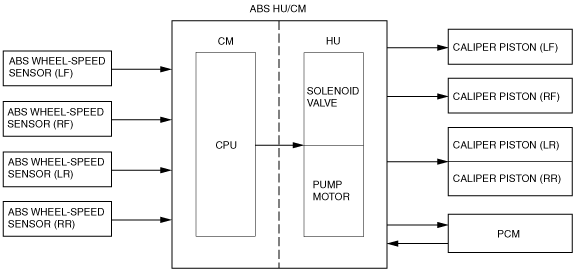ABS CONTROL
id041300183300
Outline
• ABS control occurs when wheel slip is determined by the ABS CM (based on the four ABS wheel-speed sensors). Then, the ABS HU inlet and outlet solenoid valves are operated and brake fluid pressure is controlled accordingly to prevent wheel lock-up.
Feature
• Use of ABS control during emergency braking or on slippery road surfaces allows directional stability to be maintained, steerability ensured, and stopping distance to be reduced.
• The ABS control system has independent front wheel control and unified control (select low) for the rear wheels.
-
Note
-
• Select low control: A control system in which the left and right vehicle wheel speeds are compared and brake fluid pressure is controlled according to the wheel most likely to lock-up.
Construction
Block Diagram
Operation
• When the ABS CM determines wheel slip conditions based on the signals from the ABS wheel-speed sensors during braking, the ABS CM operates the ABS HU inlet and outlet solenoid valves, reducing and maintaining brake fluid pressure in accordance with the wheel slip factors. Then, when the wheel slip condition has passed, brake fluid pressure is increased and maintained, ensuring braking with a constantly stable brake force.
Control condition transition diagram
